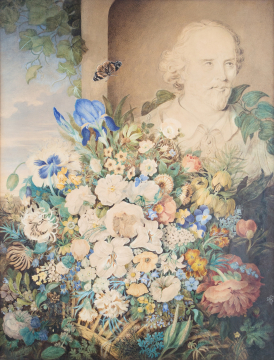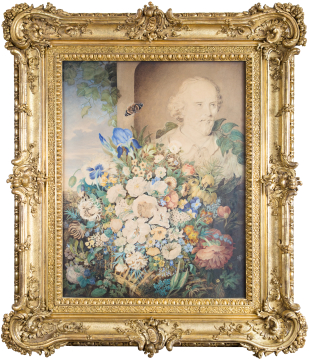Explore Collections


You are here:
CollectionsOnline
/
Shakespeare's Flowers
Browse
Clara Maria Pope, Shakespeare's Flowers, c.1835. SM P319. ©Sir John Soane's Museum, London. Photo: Lewis Bush
Mrs Clara Maria Pope (1767 - 1838)
Shakespeare's Flowers
Museum number: P319
On display: Morning Room (pre-booked tours only)
All spaces are in No. 13 Lincoln's Inn Fields unless identified as in No. 12, Soane's first house.
For tours https://www.soane.org/your-visit
Curatorial note
The earliest inventories of the Soane Museum (1837) describe this work as 'The Bust of Shakespeare encircled by all the Flowers mentioned in his Works'. The bust seems to be that of Shakespeare by Scheemakers, of which Soane owned a cast (the original is on the poet's monument in Westminster Abbey).
The novelist Mrs Barbara Hofland, whose descriptions of Soane's Museum are included alongisde his own in his 1835 Description of his house comments on this picture, hanging in what had been Mrs Soane's Morning Room as follows: “On the splendid Flowers of Mrs. Pope every eye will rest with pleasure – the design and the execution of this lovely picture reflect equal honour upon the amiable artist; for the former is highly poetical and purely feminine, the latter all the most passionate admirer of these beautiful productions of nature could wish for.”
Clara Maria Pope was formerly married to the artist Francis Wheatley (1747-1801), one of Soane’s fellow Academicians. Clara was a long-time friend of the Soane family. According to Gillian Darley, Soane's biographer, this friendship began after Wheatley died leaving Clara in a difficult financial situation. Eliza befriended her and she was often invited to join the Soane family on outings and on summer holidays [see Darley, John Soane: An Accidental Romantic p.156, p.202].
In classical literary theory, 'flowers' can refer to rhetorical ornaments or the chief beauties of a poet, and this painting plays on the double meaning of the term. The flowers mentioned in Shakespeare's own works are amassed into a basket, alluding to the mythical origins of the Corinthian order, and tilted towards a bust of the writer as if presented in tribute.
Clara Pope, like many other talented women painters of the 19th century, specialised in botanical art. This picture was commissioned by Soane, and exhibited at the Royal Academy in 1835 before being hung in the Morning Room that had once been Eliza Soane's.
The novelist Mrs Barbara Hofland, whose descriptions of Soane's Museum are included alongisde his own in his 1835 Description of his house comments on this picture, hanging in what had been Mrs Soane's Morning Room as follows: “On the splendid Flowers of Mrs. Pope every eye will rest with pleasure – the design and the execution of this lovely picture reflect equal honour upon the amiable artist; for the former is highly poetical and purely feminine, the latter all the most passionate admirer of these beautiful productions of nature could wish for.”
Clara Maria Pope was formerly married to the artist Francis Wheatley (1747-1801), one of Soane’s fellow Academicians. Clara was a long-time friend of the Soane family. According to Gillian Darley, Soane's biographer, this friendship began after Wheatley died leaving Clara in a difficult financial situation. Eliza befriended her and she was often invited to join the Soane family on outings and on summer holidays [see Darley, John Soane: An Accidental Romantic p.156, p.202].
In classical literary theory, 'flowers' can refer to rhetorical ornaments or the chief beauties of a poet, and this painting plays on the double meaning of the term. The flowers mentioned in Shakespeare's own works are amassed into a basket, alluding to the mythical origins of the Corinthian order, and tilted towards a bust of the writer as if presented in tribute.
Clara Pope, like many other talented women painters of the 19th century, specialised in botanical art. This picture was commissioned by Soane, and exhibited at the Royal Academy in 1835 before being hung in the Morning Room that had once been Eliza Soane's.
Purchased by Sir John Soane from the artist in 1835. Soane Office Day Book entry, July 22 1835, 'Mrs Pope for flower drawing £31.10.0'. The picture was accompanied by a hand-written list signed by Mrs Pope entitled 'Names of the Flowers & Herbs &c./in Mrs Pope's Drawing of Shakespeare's Flowers' which lists each flower and the name of the play in which it occurs (Soane Archive: Spiers' box file 'Papers relating to purchase &c.').
Literature
J. Soane, Description, 1835, p.92
Mary Webster, 'A Regency Flower Painter: Clara Maria Pope', Country Life May 18 1967 pp.1246-1248, fig.3.
For further detail on the subject see Jessica Kerr, Shakespeare’s Flowers, illustrated by Anne Ophelia Dowden, Longman Group Ltd, London, 1969
Mary Webster, 'A Regency Flower Painter: Clara Maria Pope', Country Life May 18 1967 pp.1246-1248, fig.3.
For further detail on the subject see Jessica Kerr, Shakespeare’s Flowers, illustrated by Anne Ophelia Dowden, Longman Group Ltd, London, 1969
Exhibition history
The Language of Flowers, Nationalmuseum, Stockholm, 22 February - 27 May 2007
Associated items
SC68, depicted
Comments
Exhib. R.A. 1835, no. 434.
Soane collections online is being continually updated. If you wish to find out more or if you have any further information about this object please contact us: worksofart@soane.org.uk





